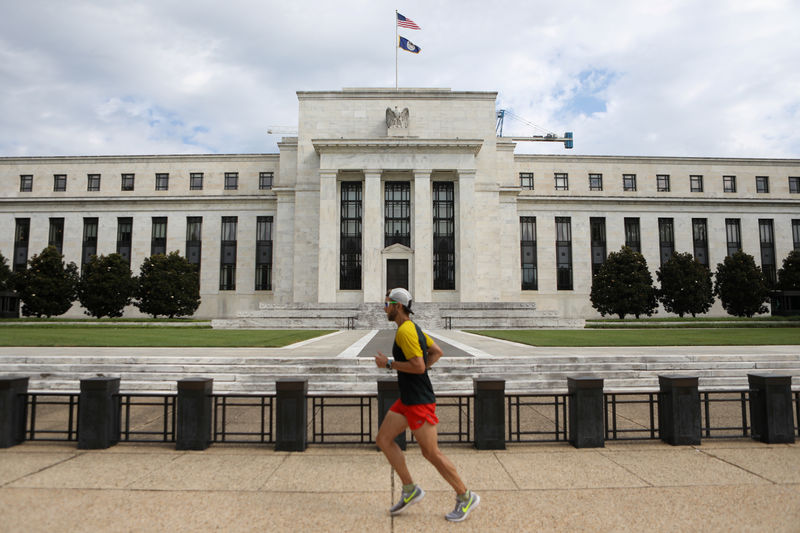By Geoffrey Smith
Investing.com -- Chances for a compromise on the next round of fiscal stimulus rise, but eyes are on the release of the Federal Reserve's minutes for hints of more immediate support. The dollar continued to weaken. Inflation runs ahead of expectations in Europe, at least for now. Stocks are expected to build on Tuesday's record close for the S&P 500 and oil is becalmed ahead of an OPEC+ meeting. Here's what you need to know in financial markets on Wednesday, August 19th.
1. Pelosi, McConnell signal willingness to compromise
The chances of a compromise deal on the latest round of economic relief measures appeared to rise after House Speaker Nancy Pelosi indicated she would drop many of her demands in order to secure a short-term deal.
“We’re willing to cut our bill in half to meet the needs right now,” Pelosi told an event organized by a Politico, adding: “We’ll take it up again in January.”
Bloomberg later reported her spokesman as clarifying her comments to mean that the Democrats would meet the skinnier Republican proposal halfway, rather than “cutting our bill in half.”
Bloomberg reported that Senate Republicans are now drafting a pared-down proposal, featuring some money for the U.S. Postal Service, supplemental unemployment payments and aid for small businesses and for school reopenings. Senate Leader Mitch McConnell said however that the Senate would not back a bill on funding the USPS currently being prepared by House Democrats.
2. Fed minutes to be scanned for policy shift signs
With fiscal policy still effectively deadlocked, the release of the minutes from the Federal Reserve’s last policy meeting at 2 PM ET (1800 GMT) is likely to garner more attention that it might otherwise do.
Most short-term economic indicators have indicated a flattening out of the rebound since the last meeting, something that will encourage market participants to parse the minutes for any language about what would be sufficient to trigger further stimulus.
John Velis, FX strategist at BNY Mellon (NYSE:BK), said in a note to clients that any sign of a move to yield curve targeting could be interpreted as a signal that the Fed is preparing fresh action. The release comes against a backdrop of mounting speculation that the Fed may shift its strategy to pursue an average inflation target over multiple years, effectively committing it to run the economy hotter for longer as it emerges from the pandemic.
Such speculation continued to weigh on the dollar on Wednesday. By 6:30 AM ET (1030 GMT), the dollar index that tracks the greenback against a basket of developed market currencies was only 0.1% above the 28-month low it hit on Tuesday at 92.237.
3. Stocks set to build on new S&P high
U.S. stock markets are set to open modestly higher, with the S&P 500 building on the new record high close it achieved on Tuesday.
By 6:30 AM ET, the Dow 30 futures contract was up 41 points or 0.1%, while US 500 Futures and Nasdaq 100 futures were up in parallel.
The day starts with an earnings update from Target and Lowe’s and discount fashion giant TJX and ends with reports from L Brands – owner of Victoria’s Secret – and, more importantly, chipmaker Nvidia.
4. Inflation ticks up in Europe
Inflation ticked up in the U.K. and euro zone in July, but analysts dismissed the development as "noise" generated by the difficulties of collating data in the current circumstances. The core CPI rate in the euro zone rose to 1.2% from 0.8%, due largely to clothes and services prices. The headline number would have been even higher without the temporary cut in VAT in Germany, whose price basket accounts for 28% of the total.
In the U.K., meanwhile, consumer prices rose 0.4% on the month, rather than the 0.1% drop expected.
In both the euro zone and the U.K. analysts say the July numbers are at odds with the longer-term trend, given the disinflationary forces created by rising unemployment and higher economic uncertainty. Claus Vistesen of Pantheon Macroeconomics noted that the drag from lower energy prices was easing, "but the truth is that we still don’t have a clear view of the underlying core inflation trend in (the euro zone)."
5 Oil calm as OPEC+ ministers review output deal
Oil ministers from most of the world’s biggest producers will gather virtually to review the state of the global market.
The Joint Ministerial Monitoring Committee convened by the so-called OPEC+ bloc, which starts at 10 AM ET, isn’t expected to recommend any major changes to production policy, given the relatively high degree of compliance with previously-agreed cuts in output.
Elsewhere, the U.S. Energy Information Administration will release its weekly assessment of crude oil inventories. The American Petroleum Institute estimated on Tuesday that crude stocks fell by 4.29 million barrels, markedly more than the 2.9 million-barrel draw expected.
Despite that, U.S. crude futures still haven’t made headway beyond the $43 a barrel level. At 6:30 AM, they were down 0.9% at $42.69, while Brent futures were down 1% at $45.01 a barrel.
